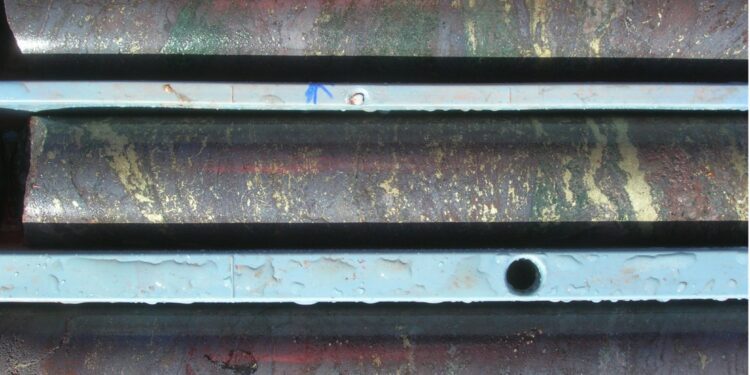Coda Minerals Limited (ASX: COD) and joint venture partner Torrens Mining Limited have unveiled significant new developments with the ongoing IOCG drilling programme at Emmie Bluff Deeps in South Australia.
The drilling programme continues to make excellent progress, providing further clarity on the nature of the emerging IOCG discovery at Emmie Bluff Deeps, which was first highlighted by parent hole DD21EB0018. This hole intersected 35m of mineralisation grading in excess of 1% copper with peak grades of 5.39% Cu within the higher grade bornite zones and 1.19g/t Au in the main chalcopyrite zone.
In its most recent major update on 23 August 2021, Coda announced assay results for recently completed wedge holes (17.1m @ 1.2% Cu, 0.3 g/t Au from 824m in DD21EB0018W1, 24.0m @ 2.2% Cu, 0.3 g/t Au from 815m and 12.9m @ 3.5% Cu, 0.6 g/t Au from 902m in DD21EB0018W2).
Since that release, the company has completed two additional surface diamond drill‐holes (DD21EBD0002 and DD21EBD0003), and a total of three wedge holes reported below. The drilling of additional wedge holes is ongoing to further define the system.
IOCG‐style mineralisation of varying thickness and tenor (as identified by visual logging of copper‐bearing sulphides, supported by hand‐held XRF) has now been intersected over a significant area, and the company’s exploration model has evolved along with the results.
Recent drilling by Coda has now demonstrated the presence of mineralisation throughout an area of at least 300m east‐west by 200m north south. The mineralisation is essentially open in all directions except directly to the north of DD21EB0018, and historical drill results provide strong evidence that lateral extension does occur beyond the bounds of recent drilling, potentially as far as 800m to historical drillhole SAE 4 or beyond.
Some of the most exciting intersections have come within the last several days from hole DD21EBD0003W2, which encountered approximately 67m of mineralisation over two vertically stacked lodes including:
- 27m of bornite‐chalcocite‐covellite mineralisation from 803m down hole in the upper lode immediately adjacent to a significant fault zone; and
- a further 40m of blebby chalcopyrite dominated mineralisation (with trace disseminated bornite) from 912.5m down hole.
Based on sulphide abundances logged by Coda’s exploration team, the upper lode bornite zone is expected to demonstrate grades comparable to or in excess of the high grade bornite zone in DD21EB0018W2 but over this thicker mineralised zone, while chalcopyrite abundances in the lower zone have been visually logged as being comparable to those in the DD21EB0018 parent hole.
Additional encouraging results have been seen in other holes. Of particular note are:
- 24m of blebby chalcopyrite and disseminated bornite mineralisation from 884.51m in DD21EBD0002W1,
- 300+m of pervasive hydrothermal alteration and disseminated trace to minor chalcopyrite from 1094.65m, also in DD21EBD0002W1, indicating the strong potential for vertical extension to depth,
- 45m of pyrite and chalcopyrite mineralisation from 880.69m in DD21EBD0002; and
- 17m of strong chalcopyrite mineralisation from 830m in an overall mineralised envelope of 46m to 876m in hole DD21EBD0003
“These exciting new visual results from our ongoing drilling take the Emmie Bluff Deeps discovery to an entirely new level. So far, we have had information for a relatively discrete area around the parent hole. These new results substantially increase the mineralised footprint of the system and show that there is a significant amount of copper present,” CEO, Chris Stevens, said.
“We are also seeing increased thicknesses of potentially economic mineralisation and, importantly, the presence of a higher grade bornite core. We are particularly encouraged by the intensity of alteration and abundance of sulphides which are being reported by our field team, as well as the fact that we are seeing far greater lateral extensions to the mineralisation than we have seen before. We are looking forward to releasing assay results as soon as possible.
“We have two drill rigs on-site currently drilling a third wedge hole each from most recently drilled parent holes EBD002 and EBD003. These wedge holes are design to follow up on the most recent wedge from EBD003W2 which appears to have intersected a major mineralising structure as evidenced by bornite and chalcopyrite rich copper sulphides logged by Coda’s geologists over a total of 67m within the hole.
“Our task now is to continue to test the areas of open mineralisation as we seek to extend the copper-rich bornite zones and to further test areas for vertical extension and additional stacked lodes.”
For further information please visit: https://www.codaminerals.com/












